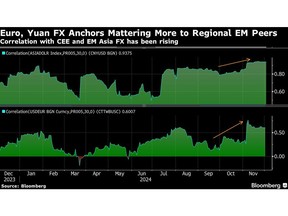Article content
(Bloomberg) — Losses in the Chinese yuan and the euro have picked up in recent months, and that is worsening the outlook for emerging-market currencies in Asia and Europe.

Losses in the Chinese yuan and the euro have picked up in recent months, and that is worsening the outlook for emerging-market currencies in Asia and Europe.

(Bloomberg) — Losses in the Chinese yuan and the euro have picked up in recent months, and that is worsening the outlook for emerging-market currencies in Asia and Europe.
Article content
Article content
That’s because the yuan and euro play a role as “currency anchors” for their smaller peers, helping to either support them or drag them down depending on the prevailing market conditions. Their anchor role has become even stronger in recent months, a study of correlations shows.
Advertisement 2
This advertisement has not loaded yet, but your article continues below.
THIS CONTENT IS RESERVED FOR SUBSCRIBERS ONLY
Subscribe now to read the latest news in your city and across Canada.
SUBSCRIBE TO UNLOCK MORE ARTICLES
Subscribe now to read the latest news in your city and across Canada.
REGISTER / SIGN IN TO UNLOCK MORE ARTICLES
Create an account or sign in to continue with your reading experience.
THIS ARTICLE IS FREE TO READ REGISTER TO UNLOCK.
Create an account or sign in to continue with your reading experience.
or
Article content
A surging dollar and the threat of higher US tariffs have dragged down the yuan and euro since the end of September. The yuan also weakened as traders grew disappointed over China’s stimulus measures, while the euro was pummeled as traders boosted bets on European Central Bank interest-rate cuts.
“Anytime China is either coming under pressure from a currency perspective or more an economic perspective, that’s going to spill over and there’s going to be contagion effects for the rest of Asia,” said Brendan McKenna, an emerging-markets economist and foreign-exchange strategist at Wells Fargo Securities LLC in New York.
“If the euro’s coming under pressure, some of the eastern European currencies are probably going to weaken as well,” he said.
The 30-day correlation between the yuan and the Bloomberg Asia Dollar Index, which tracks a basket of emerging currencies in the region, climbed to 0.95 this month, the highest level in five years. An equivalent correlation between the euro and a Bloomberg index for central and eastern European currencies rose to 0.6, from around 0.2 at the end of September. A reading of 1 would mean the two move in lockstep.
Top Stories
Get the latest headlines, breaking news and columns.
By signing up you consent to receive the above newsletter from Postmedia Network Inc.
Thanks for signing up!
A welcome email is on its way. If you don’t see it, please check your junk folder.
The next issue of Top Stories will soon be in your inbox.
We encountered an issue signing you up. Please try again
Article content
Advertisement 3
This advertisement has not loaded yet, but your article continues below.
Article content
A major reason behind the close correlations is the strong trade linkages. Exports to the euro zone make up at least 50% of total shipments from the CEE countries of Hungary, Poland and the Czech Republic. In emerging Asia, at least 20% of exports from South Korea, Indonesia and Malaysia go to China.
A weakening of the yuan or euro puts downward pressure on the currencies of their export-dependent neighbors, and can be often be welcomed as it helps keep their goods competitive.
If the yuan depreciates past 7.50 per dollar, the Reserve Bank of India may let the rupee weaken as well, so as to keep the yuan-rupee cross stable, said Wim Vandenhoeck, a senior portfolio manager at Invesco Ltd. in New York.
The prospect of higher US tariffs is set to further weigh on the yuan and euro and their emerging-market counterparts. Since his election victory in November, President-elect Donald Trump has threatened to slap 25% tariffs on imports from Mexico and Canada, and an additional 10% duties on China.
“Speculation around Trump’s policies and the tariff threats mean the CEE-4 currencies do have a target painted on them,” said Anders Faergemann, co-head of emerging markets global fixed income at Pinebridge Investments in London, referring to the main currencies of central and eastern Europe.
Advertisement 4
This advertisement has not loaded yet, but your article continues below.
Article content
“We’ve already seen some weakness in the Hungarian forint and it’s always seen as a proxy to the region,” Faergemann said. “But if we do see additional tariffs, we can see the Czech koruna bearing the brunt of the euro’s weakness.”
Stronger Dollar
The dollar is likely to remain “stronger for longer” too, which will put further pressure on the euro and yuan, and by extension, the currencies of emerging Asia and Europe, according to Goldman Sachs Group Inc.
“The euro area is particularly negatively impacted by trade uncertainty and this presents a challenging environment for the CEE economies and currencies,” said Kamakshya Trivedi, head of global foreign-exchange and interest rates at the bank in London.
In addition, “we think it will be hard for Asia low-yielder currencies to avoid spillovers from the Chinese yuan weakness that we expect,” he said.
What to Watch
—With assistance from Liau Y-Sing.
Article content
Share this article in your social network